Police Brutality: How Protesters Resist State Violence Around the World
We asked activists in seven countries to share their best strategies.
by Charlotte England
9 April 2021
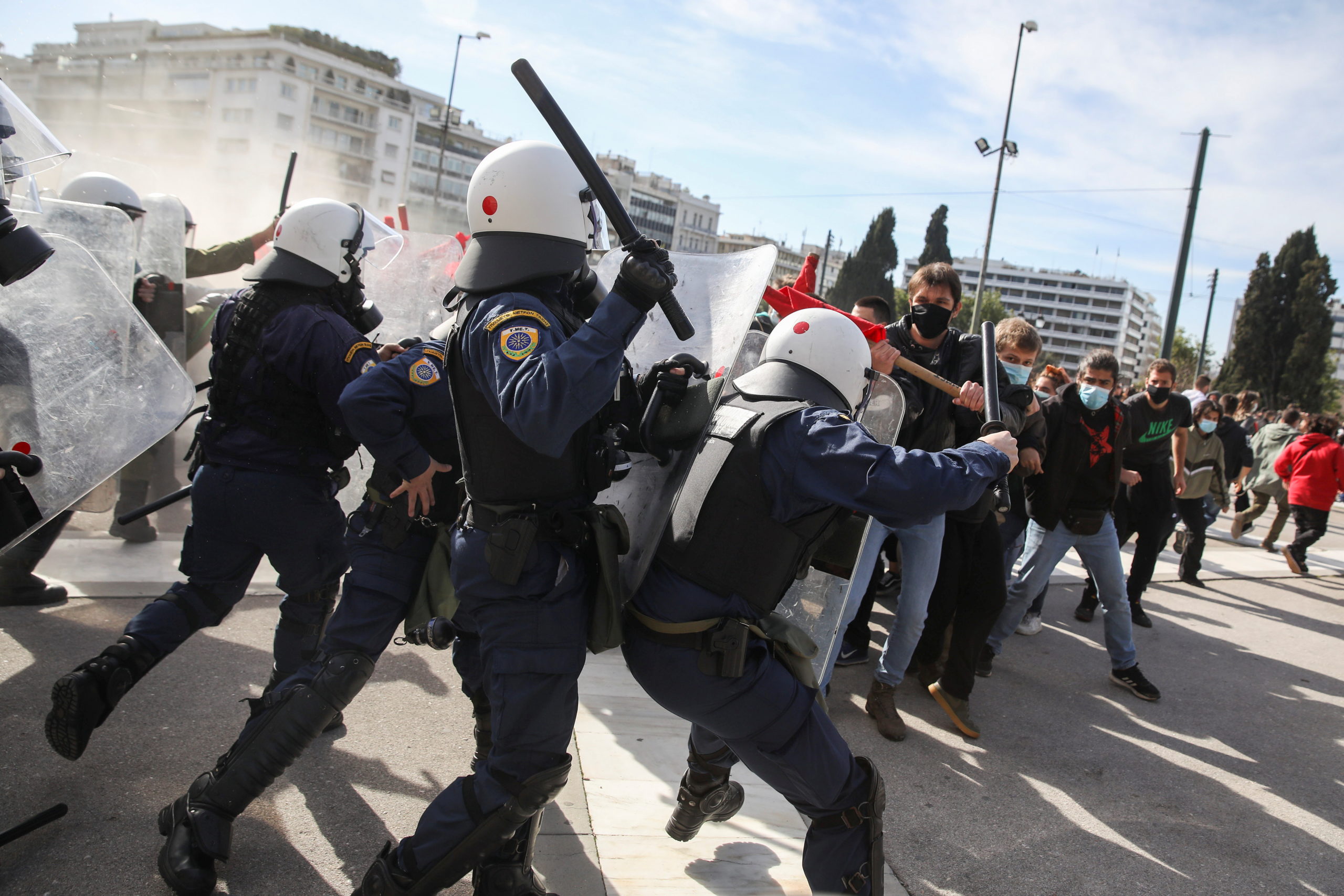
Since the police brutally dispersed a peaceful vigil in London last month, protests across the UK have been marked by violence. In Bristol, police hit protesters with riot shields and then beat them as they lay on the ground, causing head injuries. In Manchester, they dragged people away, stripping women down to their underwear in the process. Nationwide protests last weekend saw people pepper-sprayed and choked. The police, crime, sentencing and courts bill is expected to embolden police violence, justifying a continued crackdown on protest.
We know police forces around the world share tactics for how to police protests. Protesters ought to share tactics for how to defend themselves. Novara Media spoke to those organising against police violence in Myanmar, Greece, Palestine, Nigeria, Chile, Colombia and the United States about what they’re up against, their tips and strategies, and the advice they have for protesters facing police brutality in the UK.
Myanmar.
A 24-year-old NGO worker in Yangon who has been protesting every day for two months.
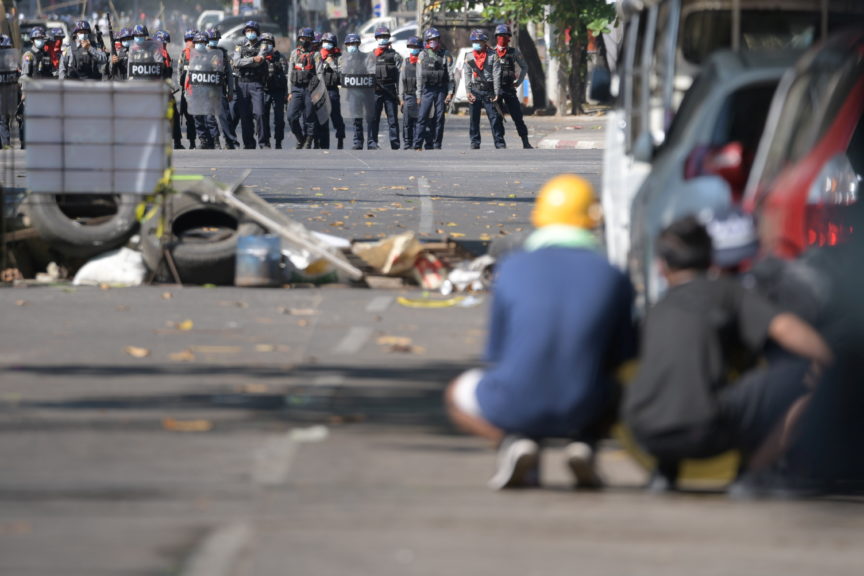
‘Get a VPN, organise on Signal, wash tear gas away with Coca-Cola and film everything.’
In Myanmar, we have been protesting all across the country since the military seized power on 1 February. Hundreds of thousands of people are taking to the streets every day in defiance of police and soldiers, who are terrorising the population with arbitrary arrests and violence. Around 550 people have now been killed, the majority of them protesters shot during demonstrations.
We have had to organise rapidly, flexibly and creatively, as the authorities have sought to crackdown on organising, including by shutting off mobile data and wireless internet at intervals.
At first, we used Facebook groups to coordinate protests, but this made it too easy for the police to infiltrate and to target organisers (many of whom have been snatched and imprisoned, some tortured and killed). So now we use VPNs to disguise our location and communicate using secure messaging apps like Signal and Telegram. I post in group channels, but to be in these groups you must be added by a friend who can vouch for you, so they snowball. Some activists are more careful still, and prefer to only pass information by word of mouth, in a chain – from one trusted individual to another, without knowing the previous person’s sources. This way, if someone is captured, they cannot inform on others.
Every day, young activists think up new ideas to keep up the momentum. Today, people have been putting red paint everywhere to represent courage. On Easter Sunday they painted protest slogans on eggs. Last month, for International Women’s Day, they hung women’s skirts from poles and washing lines because men – including police officers and soldiers – are too superstitious to walk under them, fearing it will strip away their power.
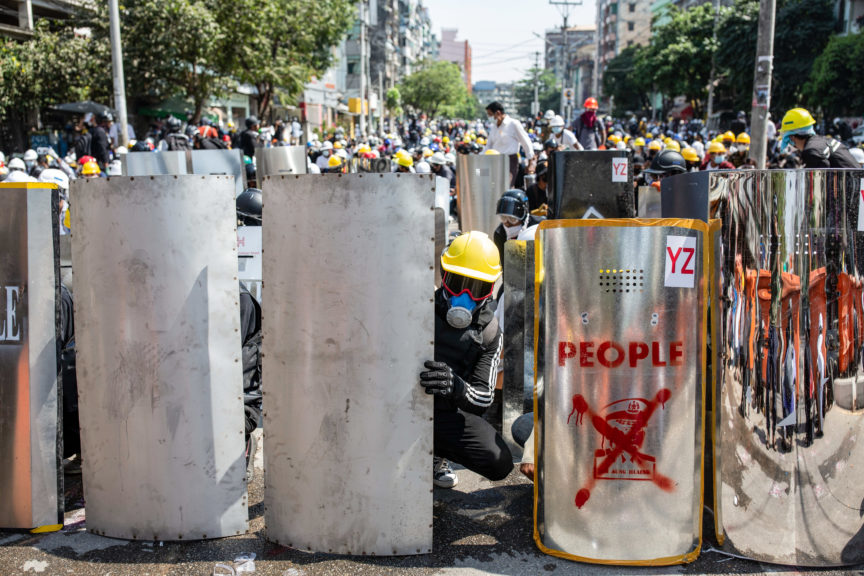
On the streets, we provide the people at the front with makeshift shields to protect from rubber bullets and gas masks for tear gas. Behind the frontlines, a team is responsible for neutralising tear gas canisters with water and wet blankets. When we do get teargas in our eyes, we’ve found that Coca-Cola is the most effective thing for washing it out.
We sometimes use fireworks to scare and distract the police with loud noises and we burn tyres to make smoke to conceal ourselves. We block the streets with barricades. All of these things work to an extent, but sometimes all we can do is run – the police and soldiers are using live ammunition, and there is nothing we can do to protect ourselves against their guns.
The generals don’t have any support from the people. They share propaganda through the state-run media, but it is obviously all ridiculous lies; it is weird to watch because everyone knows the truth. At the same time, they have banned independent media and cracked down on journalists. So we have to rely on citizen journalists, who use their phones to record what’s happening. Many of these people have been detained now too, but there are always more ordinary people stepping up. News agencies are coming to rely on their videos and photos which we share on social media.
Greece.
An activist and academic from Athens.
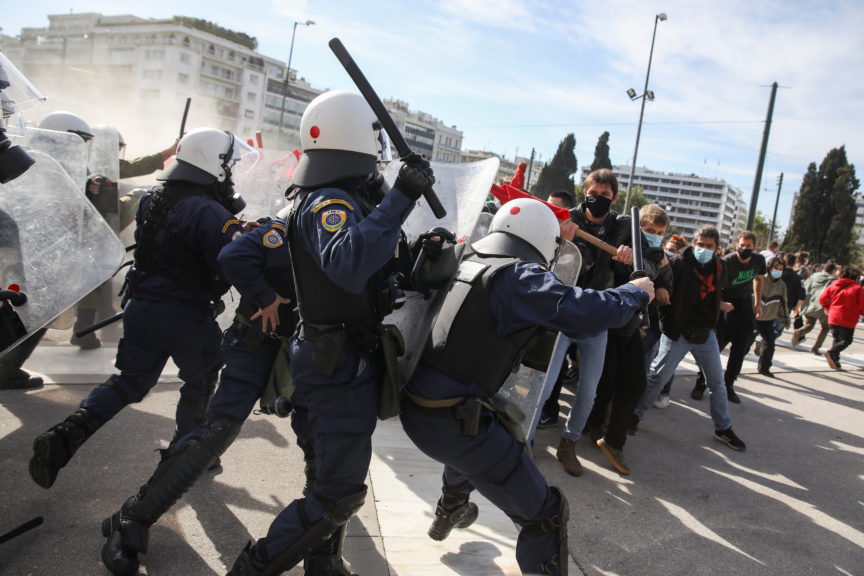
‘Form a bloc and stick together, mask up, leave a graffiti trail, gather evidence – and don’t give up.’
Greece has been in national lockdown on and off for the last year, with the current lockdown reaching five months. Civil liberties and freedom of movement have been considerably restricted through a number of emergency measures such as a night curfew. People are only allowed to leave their houses for a limited time and with a specific reason, after sending an SMS to the relevant monitoring authority. The police have been charged with enforcing these measures, leading to many incidents of abuse of power.
At the same time, the government has passed unpopular legislation to police academic institutions and has unconstitutionally criminalised the freedom to protest. The reaction of the police to any form of protest – from healthcare workers asking for more PPE to anti-fascist/pro-democracy actions to recent student protests – has been zero-tolerance and often the excessive use of violence.
Police violence and brutality date back to the very origins of the police force in Greece. Since the 2008 December riots, sparked by the police murder of Alexandros Grigoropoulos, the Hellenic police force has been procuring more and more equipment, effectively turning it into a militarised force. Police violence remains largely immune to legal scrutiny.
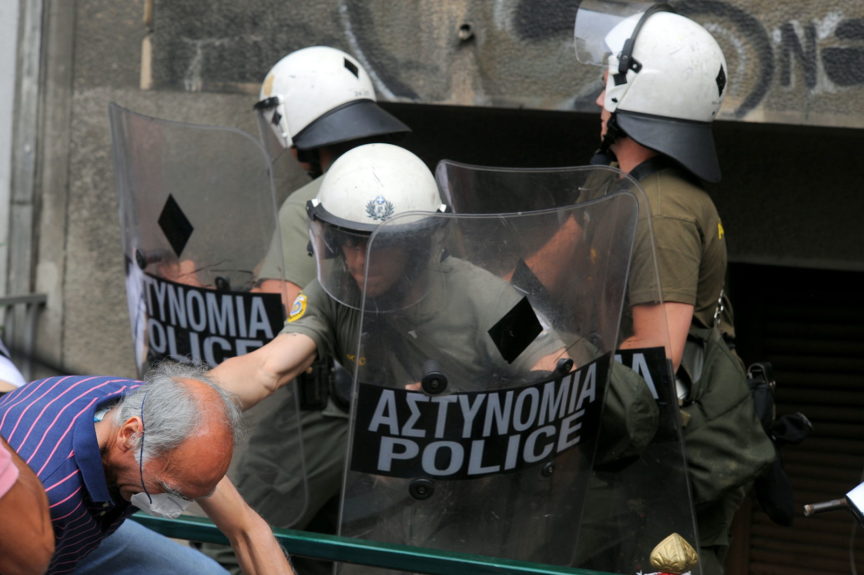
Public protests remain central to resistance in Greece. Protests regularly leave graffiti trails behind, creating a visible urban archive of the issues at hand – be it refugee rights, police brutality, climate breakdown, LGBTQ or prisoner rights – that are regularly ignored by the mainstream media.
Activists, and increasingly neighbours and passers-by, film incidents of police brutality on their phones, to disseminate via social and democratic-friendly media. A series of violent incidents in recent months have reached the public discourse solely due to citizens sharing footage on their social media that was then picked up by national media. Often social media videos are helpful in court when arrestees are falsely accused of attacking police.
The main tactic in case of police attack during mass protests remains sticking together in a bloc as much as possible and retreating in an orderly manner. In some cases, protesters make an effort to push police back, to allow people some time to retreat. Recently, a political collective that saw one of their members unlawfully kept in police detention and severely beaten for days decided to collectively file a lawsuit against the police.
Police brutality is one form of violence amongst many. Tracking devices are placed on the vehicles of activists and academics involved in rights groups, and activists are singled out by having their names and plate numbers published. One of the main acts of resistance is not to panic, but to make these practices known – and to continue being socially and politically engaged.
People have recently joined secure communication networks such as Signal and are becoming more careful when it comes to their personal security and safety. When taking to the streets, most people have a scarves to cover their faces and to protect themselves from tear gas. They use stomach antacids, such as Maalox or Riopan, to minimise the burning effects.
Activists in Greece know not to give up – even when they are scared. A fractured bone heals faster than a fractured consciousness. This is not said lightly; people like 27-year-old Vassilis Maggos have died from police beatings in Greece in the past year. Still, collective mobilisation for justice is one of the most effective ways to stand against police brutality and one of the best remedies against systemic depression. If the fear of police abuse wins over the freedom of expression and engaged social dialogue, we are effectively talking of a victory of authoritarianism.
The United States.
Jasson Perez, an abolition organiser with the Afro-Socialists & Socialists of Colour Caucus of the Democratic Socialists of America.
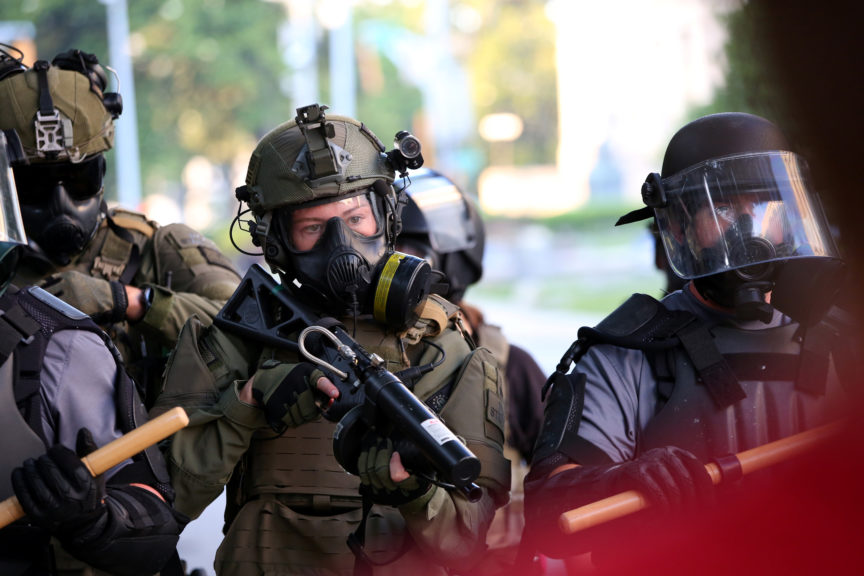
‘The aim of street protests is to control the streets – don’t coordinate with the police, shut them down.’
As someone who was formerly incarcerated, I’ve been doing abolition organising – anti-police, anti-incarceration organising – in the US for about 20 years now. Street protests have always been a big part of that, with protests escalating following the fatal shooting of Michael Brown by a police officer in Ferguson, Missouri in 2014.
A key consideration for organisers is how to build movements with longevity. Mass protests often erupt spontaneously, but to build powerful movements we need ongoing campaigns, such as campaigns to defund the police or campaigns of sustained direct action against the police. These campaigns should be rooted in organisations, yes – but they should also be open to everyone. They can enable us to strengthen movements over the long term, both in terms of tactics – such as running a regular direct action training programme – but also in terms of wider political education about the connections between police brutality and capitalism, police brutality and climate change, and so on.
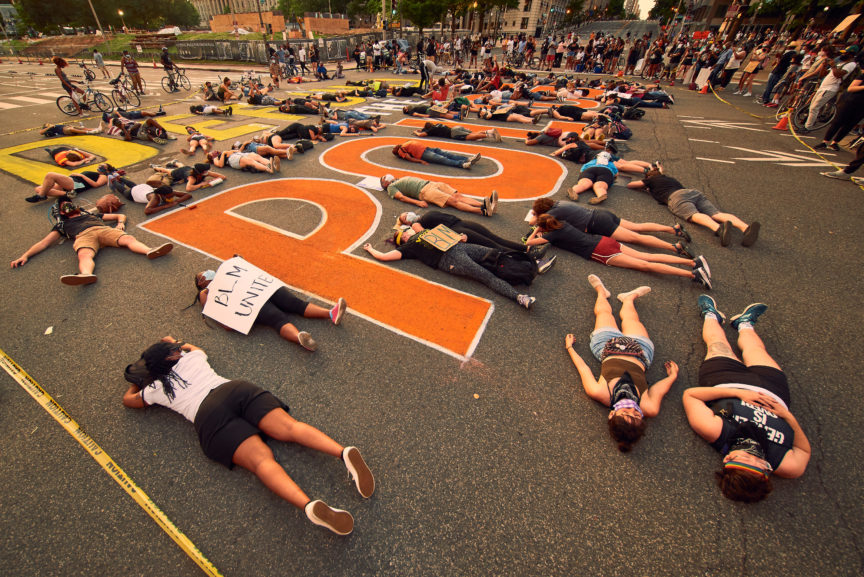
I’m of the school of thought which believes that the aim of street protests is to control the streets. We’re not there to allow police to control the streets, and we’re not there to coordinate with them. The minute you coordinate with the police, you’re not doing mass civil disobedience – you’re putting on a performance.
In terms of strategy, I’d therefore argue that in the same way that strikes aim to shut down workplaces, or climate protests aim to shut down fossil fuel infrastructure, abolition organisers should aim to shut down police stations by making police and police stations the target of their protests.
In terms of tips for resisting police brutality at protests themselves, one tactic can be to attempt to de-arrest other protesters. If one of your friends is grabbed up, and particularly if the police are being violent, your first job is to get as many people as possible to put their bodies between your friend and the police. You then want the police surrounded by more and more people chanting ‘let them go, let them go’ in order to put as much pressure as possible on the police to release them. De-arrests are something that takes practice, though – that’s the only way they’ll be successful.
Palestine.
Riya Al’Sanah, a Palestinian researcher and research coordinator at the Who Profits Research Centre.
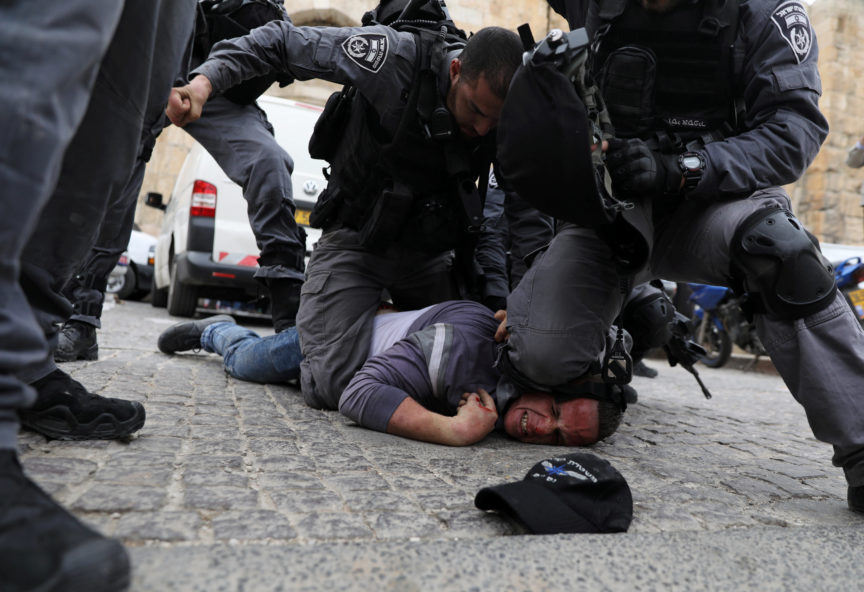
‘Understand the police in context, build a mass movement that is intersectional, and stay hopeful.’
Around two million Palestinians live in Palestine ‘48 (Israel today). Here the security arm of the Israeli settler-colonial state that governs over us is the Israeli police. In the West Bank and Gaza, it’s military rule. In Palestine ‘48, the Israeli police have been acting in two specific ways to increase violence and repress Palestinians. One is by facilitating the spread of arms within the Palestinian community to encourage intra-communal violence, which has increased massively over the past five or six years. The other is by targeting Palestinians in their racialised policing. Only a few days ago, Munir Anabtawi, a 33-year-old from Haifa who suffered from mental health issues, was shot by the Israeli police after his mum called them to help take him to hospital. Anabtawi was shot five times – three shots in the back, two in the chest. He was in need of care, and instead was executed by the Israeli police. This is not a singular case. Between 2012-2017, 70% of those killed by the Israeli police have been Palestinians, despite representing just 20% of Israel’s population.
What the movement is doing now is putting these numbers into context and politicising them. We’re not talking about police reforms. We’re talking about the police as an institution inherent to the Israeli settler-colonial state under which we live, one that engages with Palestinians – not just in Palestine ‘48, but in the West Bank and Gaza too – as a collective to be controlled, surveyed and repressed. The police will never protect us, nor will the Israeli state ever deliver us justice. So, the question becomes: how do we build our own institutions and structures to protect ourselves? This is quite different from the trend advanced by some sections of the Palestinian political leadership over the past 20 years of integration into the orbit of the state.
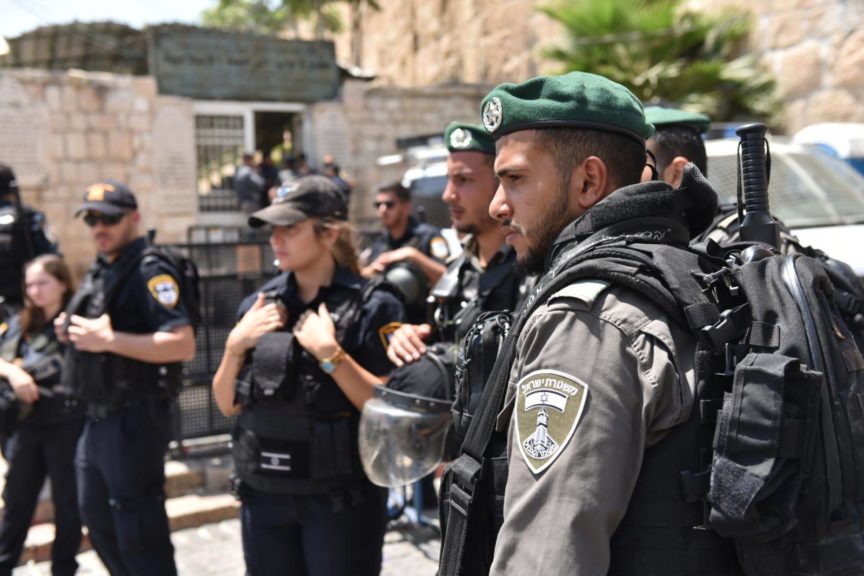
The movement today is trying to develop alternative ways of doing politics and building power, not only to protect ourselves in the here and now, but to build a freer and more just future. A lot of that organising has been happening in a city called Umm al-Fahm, where over the past two months there have been public meetings and big weekly demonstrations. What’s interesting is that during this time, the levels of violence in the city have massively decreased.
I have three pieces of advice for organisers. The first is to expand your analysis of the roots of police brutality beyond the institution of policing to the state. The second is building a mass movement that is attentive to the multi-layered nature of police brutality and how it intersects with race, class and gender. The third is to centre hope in our movements. We do not engage in struggle solely to dismantle the repressive and exploitative structures which make our lives a misery, but to build a better future. Resisting police brutality and calling for its abolition is part of this process.
Nigeria.
Gbenga Komolafe, general secretary of the Federation of Informal Workers Organisation of Nigeria (FIWON).
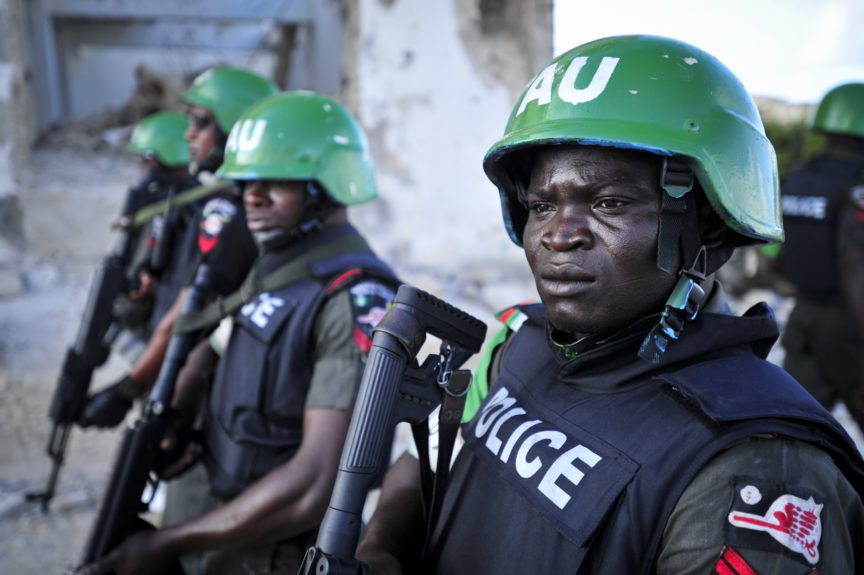
‘Use social media to expose police brutality, and raise funds to support protesters.’
Police brutality has been a part of everyday life in Nigeria for as long as I can remember – police shootings, police harming civilians at checkpoints. Following new revelations about abuses by the country’s notorious police unit, the Special Anti-Robbery Squad – or SARS – alongside worsening economic conditions for the majority of Nigerians, in October last year a huge protest movement erupted against both SARS and economic inequality more widely.
The #EndSARS protests themselves then became sites of unprecedented state violence. On 20 October, a crowd of young protesters sitting at the Lekki toll gate in Lagos were massacred when military vehicles blocked both exits and opened fire. The following day, hundreds more were killed in Lagos and in states across the country. While the government denied the casualties, the brutality led to intensified protests nationwide, during which homes and warehouses of prominent politicians hoarding massive amounts of Covid-19 relief materials were stormed and looted by angry protesters.
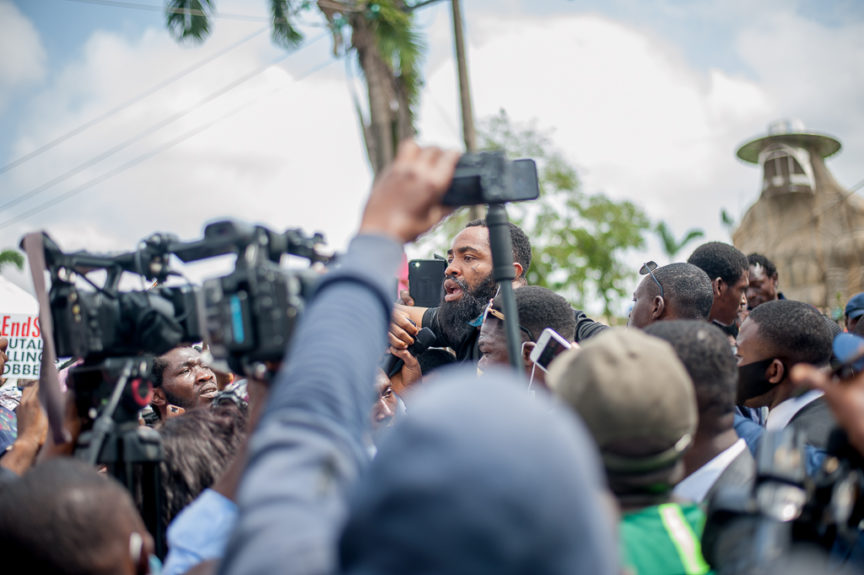
There are important things that protesters in Nigeria have had on their side, however. One is social media. Thousands of young people, who took photos and videos of the violence on their smartphones and uploaded them to Facebook, Instagram and Twitter, played a key role in exposing the brutality of the police. What’s more, the videos also exposed the government’s lies to the extent that Nigeria’s political class was totally discredited.
It’s also important to emphasise the role of women – specifically the Feminist Coalition, many of whom are based internationally – in sustaining the protest movement. The coalition raised hundreds of thousands of dollars in order to support the crowds, including serving food, paying for legal aid for those arrested and for the hospital bills of the wounded.
While police violence in the UK is obviously very different to the situation in Nigeria – the police in Nigeria are a lot more brutal, and a lot more corrupt – there are important lessons here in what’s needed to sustain movements.
Chile.
Claudia Mendez, an activist who took part in protests that began in October 2019.
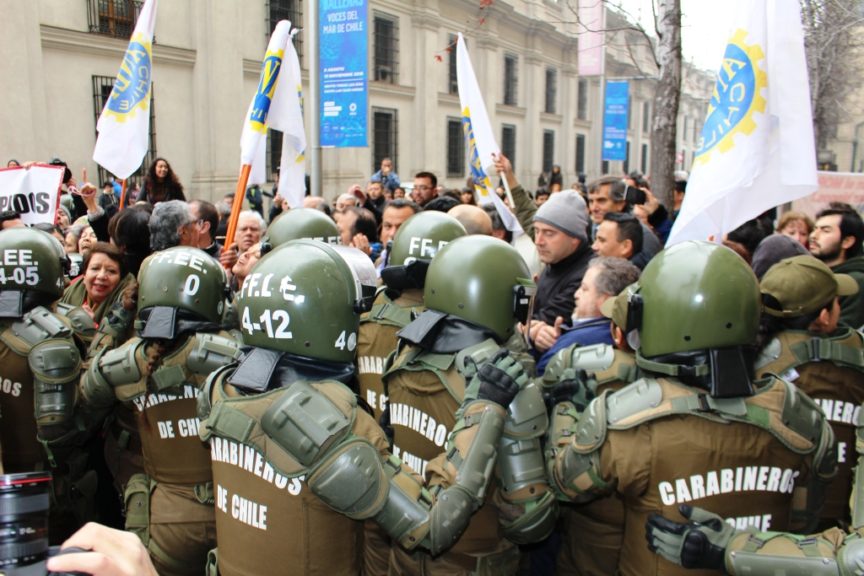
‘Coordinate and assign roles, deactivate tear gas bombs, gather bricks and build barricades.’
Police brutality peaked after the student-led ‘Estallido Social’ protests on 18 October 2019, which triggered the violence we’re still seeing now. But there’s always been police abuse towards poorer classes. The Estallido Social just made this abuse more obvious: thousands have lost their eyes due to rubber bullets; 40 have died; thousands have been arrested. There’s also awful police violence against the Mapuche people, whose territory has been militarised.
Many factors triggered 18 October. There’s profound economic inequality: privatisation of basic services, low wages, many issues with social housing, public education and public healthcare. There are also many environmental problems: exploitation of natural resources, deforestation, water scarcity.
It’s a working-class movement, very much about discontent with political parties. There is a very radical, powerful group of young activists – ‘La Primera Línea’ [the frontline], the protesters at the ‘Plaza de la Dignidad’ in central Santiago. They’ve maintained a constant resistance, in close combat with the police. Thanks to this, it is also possible to protest peacefully.
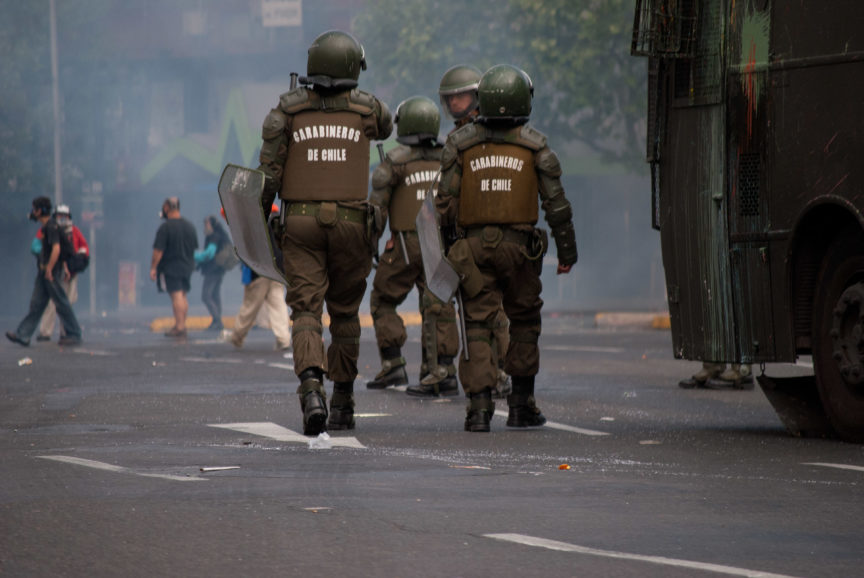
There are new forms of coordination: people have distinct roles – for example, some are in charge of deactivating tear gas bombs, others gathering bricks. There also seems to be spontaneous organisation. In the periphery of Santiago, the poor sectors, there are many barricades, where young people wait for the police and confront them.
In the upcoming elections, people will vote for so-called ‘constituents’ who will write the new constitution – supposedly a win for the Estallido Social. But many see this as a concession, as it’s very difficult for independent candidates to get a look in. There’s so much mistrust and discontent around the election, so as a strategy of resistance it might be futile. Perhaps it will generate, after the pandemic, another Estallido Social.
Colombia.
Juan David Páramo, a medical volunteer who has been active in protests since 2019 and was particularly involved in the September 2020 protests against police brutality.
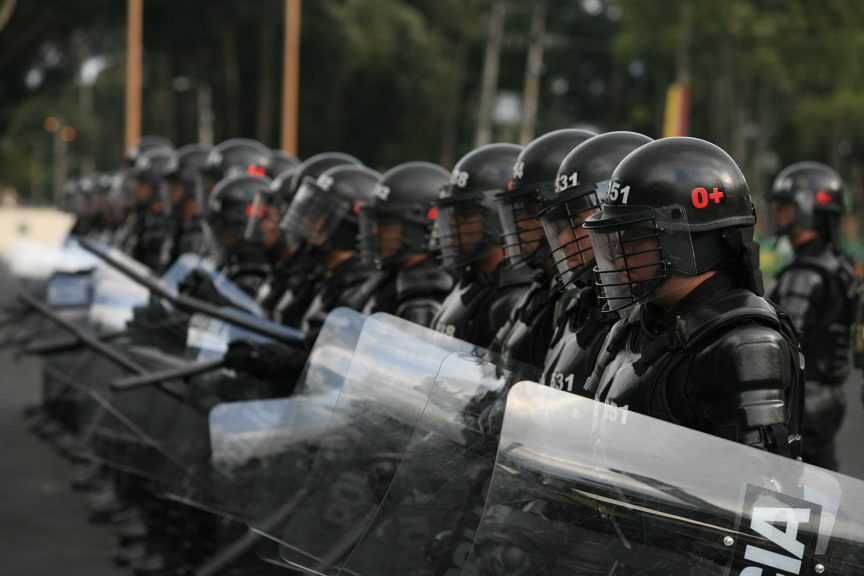
‘Diversify your tactics to include rallies, assemblies, strikes, confrontations, barricades and motorway occupations.’
Colombia has recently seen the militarisation of public life and the use state structures to silence critical voices. The enemies of these policies are young people and anyone critical of the established state order. In this context, the ESMAD [Mobile Anti-Disturbances Squadron] was created – a public order deployment force that has faced serious criticism for murders and malpractice. Its purpose is to quell public unrest.
In terms of strategies for resisting police violence, we have what we call a ‘repertoire of collective action – rallies, assemblies, strikes, ‘tropeles’ [confrontations with the police], barricades and motorway occupations. What we’re seeing now is the culmination of all the protests that have come before – of the civic strike of 1977, of the fights in public universities. These experiences are all being drawn upon to defend and strengthen the movement.
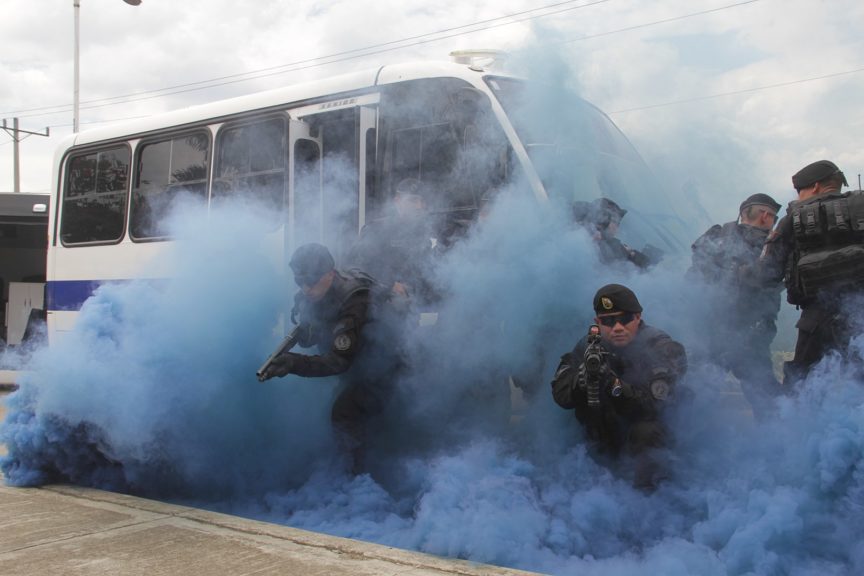
A group called ‘los escudos azules’ [the blue shields] has recently formed with the aim of defending the movement from police attacks. These are young people who wear hoods to protect themselves; having faced eye trauma [from tear gas], for example, nowadays more and more protesters are wearing protective clothing. Another important aspect of the movement’s strategy, drawn from Colombia’s farmer and indigenous resistance, is to have ‘teams’ covering human rights, communications and health.
When people become less afraid of confrontation with the police, the violence escalates. Most of the time, protesters will throw stones – and then the ESMAD arrives and shoots bullets containing pellets and glass, which have taken so many lives. Other times, protesters will throw Molotov bombs. This is risky, of course, but you have to assess that risk in terms of what you’re up against. Protesters often need to use these tactics for self-defence if the authorities are very violent.
Charlotte England, Clare Hymer, Rivkah Brown, Camille Mijola and Sophie K Rosa contributed to this piece.
Charlotte England is a director and deputy head of articles at Novara Media.


